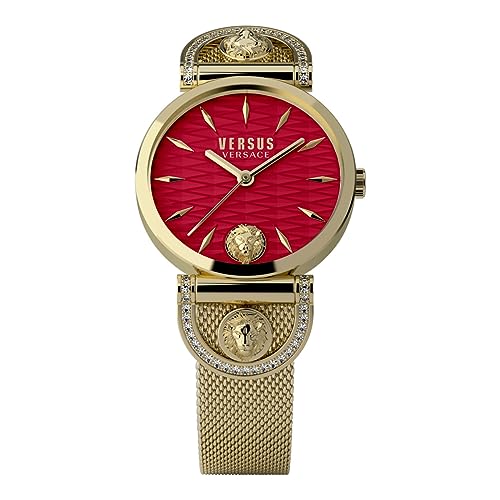In an age dominated by digital displays and fleeting trends, luxury watches stand as enduring symbols of craftsmanship, precision, heritage, and personal style. More than mere instruments for telling time, these horological masterpieces are intricate works of art, feats of engineering, and often, valuable investments passed down through generations. The allure of a luxury watch lies not just in its function, but in the story it tells – of innovation, meticulous assembly, prestigious materials, and the timeless pursuit of mechanical perfection. Understanding this world involves appreciating both the technical prowess and the aesthetic artistry that define these exceptional timepieces.
For enthusiasts and potential buyers alike, navigating the realm of luxury watches can be both exciting and daunting. With a multitude of esteemed brands, complex terminology, varying styles, and significant price points, making an informed decision requires a foundational knowledge of what sets these timepieces apart. It’s about recognizing the difference between a simple watch and a finely crafted instrument that represents centuries of horological tradition.
This comprehensive guide aims to demystify the world of luxury watches. We will explore the defining characteristics that elevate a watch to luxury status, introduce some of the most iconic and respected brands, delve into the intricacies of watch movements and complications, discuss the materials used in their creation, offer guidance on selecting a watch that aligns with your personal style and investment goals, and touch upon the importance of care and authentication. Prepare to embark on a journey into the fascinating and prestigious world of fine timekeeping.
What Defines a Luxury Watch? Beyond the Price Tag
The term “luxury” can be subjective, but when applied to watches, it generally signifies a combination of specific attributes that go far beyond simply being expensive. A true luxury watch embodies a commitment to excellence in several key areas, distinguishing it from mass-produced timepieces.
Exceptional Craftsmanship and Finishing
This is perhaps the most defining characteristic.
Meticulous Assembly:
Luxury watches are often hand-assembled, or involve significant hand-finishing, by highly skilled watchmakers. Each component, from the tiniest screw to the intricate movement parts, is crafted and fitted with extreme precision.
Attention to Detail:
The level of finishing on the movement (visible through an exhibition case back or even hidden within), the dial, hands, case, and bracelet is extraordinary. This includes techniques like Côtes de Genève (Geneva stripes), perlage (circular graining), anglage (bevelling edges), and mirror polishing, all executed to perfection. These details often require hours of skilled labor.
High-Quality Materials
Luxury watches utilize superior materials chosen for their durability, beauty, and prestige.
Precious Metals:
Gold (yellow, white, rose), platinum, and sometimes titanium are commonly used for cases and bracelets.
Superior Stainless Steel:
High-grade stainless steel alloys (like 904L used by Rolex, or 316L) offer excellent corrosion resistance and can be polished to a high luster.
Sapphire Crystal:
The “glass” covering the dial is almost invariably made from synthetic sapphire crystal, which is extremely hard and scratch-resistant (second only to diamond).
Exotic Materials:
Some brands incorporate ceramics, carbon fiber, or other advanced materials for specific properties or aesthetics.
Sophisticated Mechanical Movements
While some luxury brands produce high-end quartz watches, the heart of most traditional luxury watches is a complex mechanical movement.
In-House Calibers:
Many prestigious brands develop and manufacture their own movements (“in-house” or “manufacture” calibers), showcasing their horological expertise and ensuring complete control over quality and design. This is a significant mark of a high-end luxury watch.
Intricate Complications:
Beyond telling time, mechanical movements can incorporate various “complications” – additional functions like chronographs (stopwatches), perpetual calendars, moon phases, tourbillons (to counteract gravity’s effect on accuracy), minute repeaters (chiming the time), etc. Each complication adds significant complexity and value.
Brand Heritage and Prestige
The history and reputation of the watchmaker play a crucial role.
Longevity and Tradition:
Many luxury watch brands have centuries of continuous history, pioneering innovations and maintaining traditions of watchmaking excellence (e.g., Patek Philippe, Vacheron Constantin, Jaeger-LeCoultre).
Reputation for Quality and Innovation:
Brands build prestige through consistent quality, groundbreaking technical achievements, iconic designs, and association with significant historical events or personalities. The name on the dial of a luxury watch carries weight.
Timeless Design and Aesthetics
Enduring Style:
Many luxury watch designs are iconic and have remained largely unchanged (or subtly evolved) for decades, transcending fleeting fashion trends (e.g., Rolex Submariner, Cartier Tank, Omega Speedmaster).
Balanced Proportions:
Attention is paid to the harmony of the case, dial, hands, and bracelet, creating a visually pleasing and comfortable wearing experience.
Exclusivity and Rarity
Limited Production:
Many high-end luxury watches are produced in limited numbers due to the time and skill required for their creation, contributing to their exclusivity and sometimes their resale value. Some models have long waiting lists.
Collectively, these factors – craftsmanship, materials, movement sophistication, heritage, design, and exclusivity – contribute to the definition and desirability of a luxury watch, making it much more than just an expensive accessory.
Iconic Luxury Watch Brands: Pillars of Horology
The world of luxury watches is populated by numerous esteemed brands, each with its unique history, design language, and technical specialties. While an exhaustive list is beyond the scope of this guide, certain names consistently stand out as pillars of the industry, renowned for their contributions to watchmaking.
(Note: This is not a ranking, but a selection of highly regarded and influential brands. Many other excellent luxury brands exist.)
Rolex
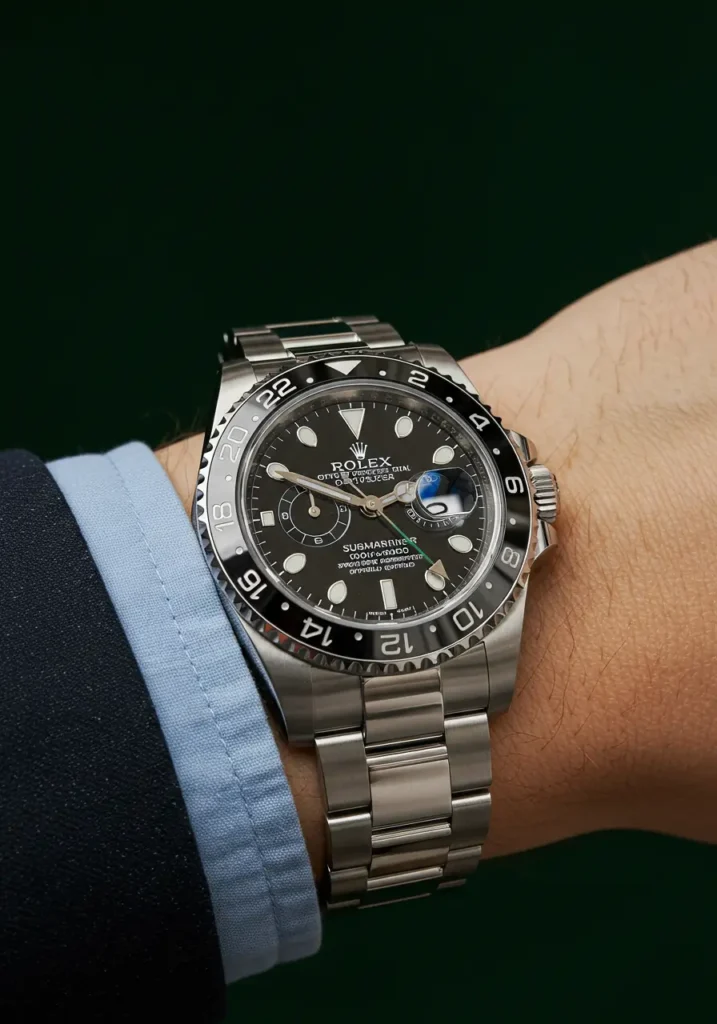
Reputation:
Perhaps the most recognized luxury watch brand globally, Rolex is synonymous with precision, durability, and timeless sporty-elegant designs. Known for pioneering innovations like the waterproof Oyster case and the self-winding Perpetual rotor.
Iconic Models:
Submariner (dive watch), Daytona (chronograph), Datejust (classic dress/everyday), GMT-Master II (dual time zone), Explorer.
Key Characteristics:
Robust in-house movements (“Superlative Chronometer” certified), high-quality materials (Oystersteel, Rolesor, precious metals), exceptional resale value for many models, strong brand image. A benchmark for many when considering luxury watches.
Patek Philippe
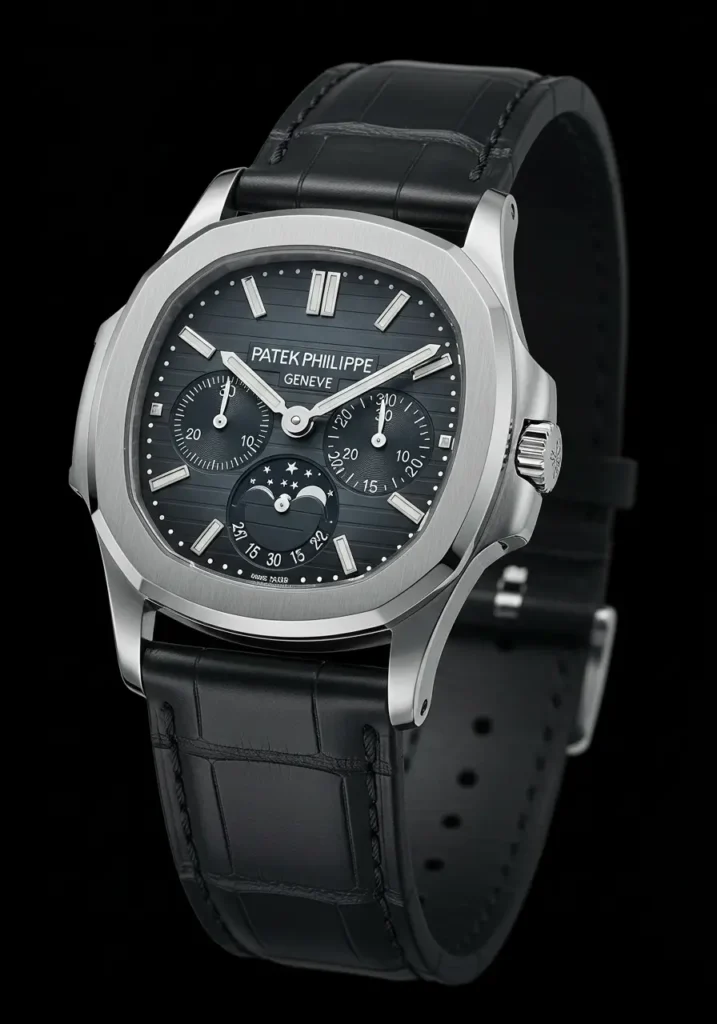
Reputation:
Considered by many to be the pinnacle of Swiss watchmaking, Patek Philippe is revered for its exquisite craftsmanship, highly complicated movements, timeless designs, and strong investment value. Famous for the slogan, “You never actually own a Patek Philippe. You merely look after it for the next generation.”
Iconic Models:
Calatrava (classic dress watch), Nautilus (luxury sports watch designed by Gérald Genta), Aquanaut (sporty), Grand Complications (minute repeaters, perpetual calendars).
Key Characteristics:
Exceptional hand-finishing, mastery of complex complications, in-house movements often bearing the Patek Philippe Seal, strong auction performance, family-owned independent company.
Omega
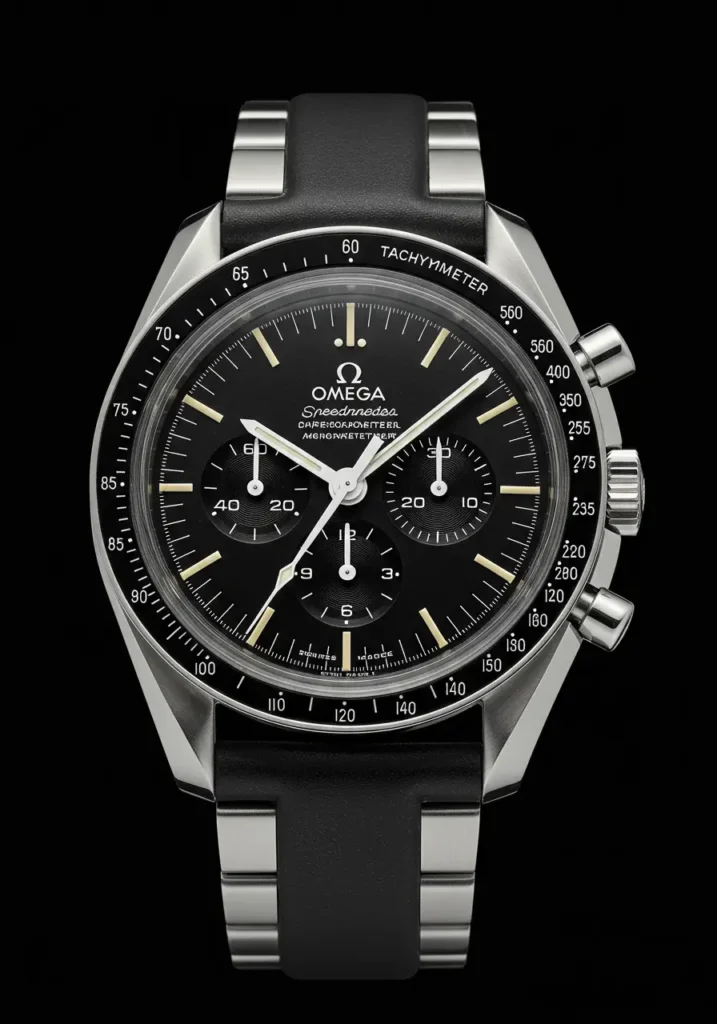
Reputation:
A historic Swiss brand known for its pioneering spirit, robust sports watches, and connection to significant events like the moon landing (Speedmaster) and James Bond films (Seamaster). Renowned for its Co-Axial escapement technology and Master Chronometer certification (high resistance to magnetism).
Iconic Models:
Speedmaster Professional (“Moonwatch”), Seamaster (dive watches, Aqua Terra), Constellation, De Ville.
Key Characteristics:
Strong focus on technical innovation and anti-magnetism, wide range of styles from tool watches to dress watches, good value proposition within the luxury segment, strong brand recognition.
Cartier

Reputation:
While also a renowned jeweler, Cartier has a rich horological history, credited with popularizing the wristwatch for men in the early 20th century. Known for its distinctive, elegant case shapes and Parisian chic.
Iconic Models:
Tank (rectangular dress watch), Santos (early pilot’s watch), Panthère, Ballon Bleu.
Key Characteristics:
Strong design DNA, unique case shapes (square, rectangular, tonneau), Roman numeral dials, blue cabochon crowns, appeals to both men and women. Many models feature reliable Swiss movements (some in-house, some sourced). Often considered a “jeweler’s watch” but with legitimate watchmaking heritage.
Audemars Piguet
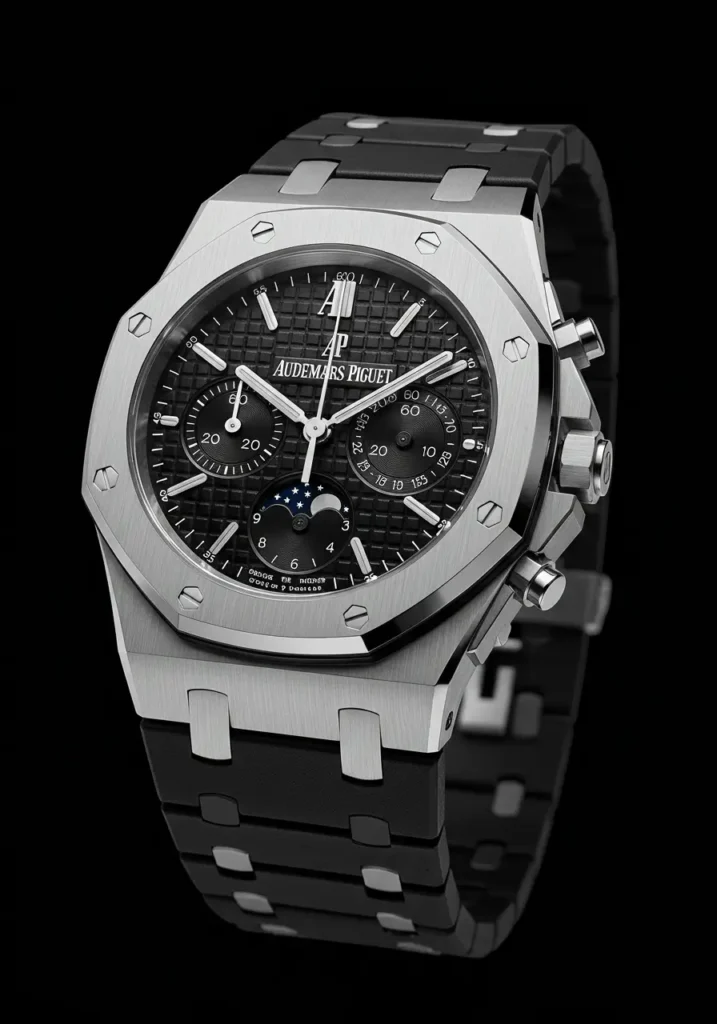
Reputation:
One of the “Holy Trinity” of Swiss watchmaking (along with Patek Philippe and Vacheron Constantin), Audemars Piguet is celebrated for its bold designs, exceptional finishing, and mastery of complications. Best known for revolutionizing the luxury sports watch category with the Royal Oak.
Iconic Models:
Royal Oak (iconic octagonal bezel sports watch designed by Gérald Genta), Royal Oak Offshore (larger, sportier version), [CODE 11.59].
Key Characteristics:
Distinctive Genta design language, exceptional movement finishing (often visible), highly sought-after models, independent family-owned company. Their luxury watches are often bold statements.
Jaeger-LeCoultre (JLC)
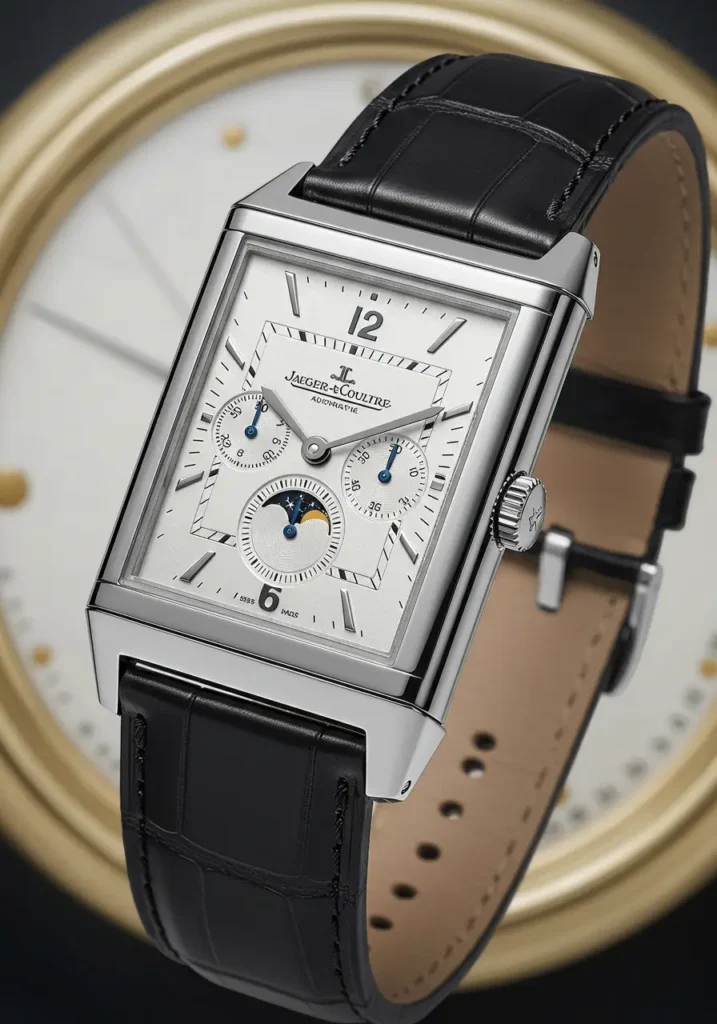
Reputation:
Known as “the watchmaker’s watchmaker” due to its history of supplying movements to other prestigious brands. JLC is highly respected for its technical innovation, extensive range of in-house movements, and iconic reversible Reverso model.
Iconic Models:
Reverso (rectangular watch with a swiveling case), Master Control series (classic round watches), Polaris (sports watches), Atmos (clock that runs on temperature changes).
Key Characteristics:
Huge catalog of in-house calibers (over 1,200), mastery of complications, classic and innovative designs, strong focus on technical prowess.
Also Read: Braces Colors: Selecting the Perfect Shades for Your Smile
Other highly respected brands include Vacheron Constantin, Breitling, IWC Schaffhausen, Panerai, Hublot, Zenith, Blancpain, Breguet, Grand Seiko (Japanese, but widely considered luxury), and many more. Exploring the specific heritage and offerings of different brands is a key part of the journey into luxury watches.
The Heart of the Matter: Understanding Watch Movements
The movement, or caliber, is the internal mechanism that powers a watch and makes its hands move. In luxury watches, the movement is often a significant point of pride and craftsmanship, especially mechanical movements.
Mechanical Movements: The Traditional Choice
Mechanical movements operate without batteries, powered by a wound spring.
1. Manual-Winding (Hand-Wound):
- How it Works: The watch is powered by a mainspring that must be wound periodically (usually daily or every other day) by turning the crown. The unwinding spring releases energy at a controlled rate through a series of gears and an escapement, which drives the hands.
- Pros: Traditional and classic, often thinner cases due to no rotor, direct connection to the watch (the ritual of winding).
- Cons: Requires regular winding to keep running. If forgotten, the watch stops.
2. Automatic (Self-Winding):
- How it Works: Also uses a mainspring, but incorporates an oscillating weight (rotor) that spins with the motion of the wearer’s wrist. This spinning rotor automatically winds the mainspring, keeping the watch powered as long as it’s worn regularly.
- Pros: Convenient (no need for daily winding if worn regularly), often preferred for everyday luxury watches.
- Cons: Can be slightly thicker than manual-wind due to the rotor. Will stop if not worn for an extended period (typically 36-72+ hours, depending on power reserve) unless placed on a watch winder.
Quartz Movements: Precision and Practicality
How it Works:
Powered by a battery. The battery sends an electrical current through a tiny quartz crystal, causing it to vibrate at a very precise frequency (typically 32,768 times per second). An integrated circuit counts these vibrations and uses them to generate regular electrical pulses, which drive a small motor that moves the hands.
Pros:
- Highly Accurate: Generally more accurate than mechanical movements.
- Low Maintenance: Requires only battery changes every few years. No winding needed.
- Durable: Fewer moving parts, often more resistant to shocks.
- Often Slimmer and Lighter: Movements can be very compact.
- Less Expensive (Generally): Simpler to manufacture.
Cons:
- Lacks “Soul” for Purists: Many traditional watch enthusiasts prefer the craftsmanship and intricate mechanics of mechanical movements. The sweep of a mechanical second hand is often smoother than the “tick-tock” of a quartz.
- Battery Dependence: Requires battery replacement.
Luxury Quartz:
While most luxury brands focus on mechanical, some produce very high-end quartz movements with excellent finishing, advanced features (like perpetual calendars or thermocompensation for extreme accuracy), or as options in ladies’ watches or specific sporty lines (e.g., Breitling Professional, Grand Seiko 9F Quartz).
The choice between mechanical (manual or automatic) and quartz often comes down to personal preference – the romance of traditional watchmaking versus the practicality and precision of modern electronics. For many collectors, the mechanical movement is a defining feature of a true luxury watch.
Watch Complications: Beyond Telling Time
In horology, a “complication” refers to any function on a watch that goes beyond simply displaying hours, minutes, and seconds. Luxury watches often showcase the watchmaker’s skill through the incorporation of various useful or highly intricate complications.
Common and Useful Complications
Date Display:
Perhaps the most common complication, showing the current date of the month, usually in a small window on the dial.
Day-Date Display:
Shows both the day of the week and the date of the month (e.g., Rolex Day-Date).
Chronograph (Stopwatch):
Allows the wearer to measure elapsed time. Features additional pushers (buttons) to start, stop, and reset sub-dials that track seconds, minutes, and sometimes hours. Very popular in sports watches.
GMT / Dual Time Zone:
Displays a second time zone, often via an additional 24-hour hand and a corresponding bezel or chapter ring. Useful for travelers or those communicating across time zones.
Power Reserve Indicator:
Shows the amount of remaining energy stored in the mainspring of a mechanical watch, indicating how long it will run before needing to be wound.
More Complex and Prestigious Complications
These often represent significant horological achievements.
Annual Calendar:
Displays the day, date, and month, automatically adjusting for months with 30 or 31 days. Only needs manual correction once a year (at the end of February).
Perpetual Calendar:
A highly complex mechanism that correctly displays the day, date, month, and often the leap year, automatically accounting for months of different lengths and leap years. Theoretically, it won’t need manual adjustment for over 100 years (until the next secular year exception).
Moon Phase Display:
Shows the current phase of the moon (new, crescent, full, etc.) as it appears in the sky, usually via a rotating disc visible through an aperture on the dial. An aesthetic and traditional complication.
Tourbillon:
Invented by Abraham-Louis Breguet to counteract the effects of gravity on the accuracy of a pocket watch’s escapement (by housing it in a rotating cage). While its practical necessity in modern wristwatches is debated, it remains a visually captivating display of high watchmaking skill and adds significant cost.
Minute Repeater:
A highly prized and complex complication that chimes the time on demand using tiny hammers and gongs within the movement. Activating a slide or pusher causes it to chime the hours, quarter-hours, and minutes. Represents a pinnacle of horological artistry.
“Grand Complications”
A watch featuring multiple highly complex complications (often a perpetual calendar, minute repeater, and chronograph) is termed a “Grand Complication” and represents the ultimate expression of a watchmaker’s skill and prestige within the world of luxury watches.
The presence and complexity of complications significantly influence a luxury watch’s character, functionality, and price.
Choosing Your Luxury Watch: A Personal Journey
Selecting a luxury watch is a deeply personal decision, involving a blend of practical considerations, aesthetic preferences, and sometimes investment goals. There’s no single “best” watch; the right one is what resonates with you.
1. Define Your Budget
Realistic Expectations:
Luxury watches span a vast price range, from a few thousand dollars for entry-level models from reputable brands to hundreds of thousands or even millions for highly complicated or rare pieces. Establish a comfortable budget range before you start seriously looking.
New vs. Pre-Owned:
The pre-owned market can offer significant savings on luxury watches, often allowing access to models or brands that might be out of reach when new. However, buying pre-owned requires diligence in authentication and verifying seller reputation.
2. Consider Your Lifestyle and Intended Use
Daily Wearer:
If you plan to wear the watch every day, durability, comfort, and versatility are key. Stainless steel sports watches (like a Rolex Submariner or Omega Seamaster) or robust dress-casual models often fit this bill. Water resistance might be important.
Dress Watch for Formal Occasions:
For special events, a slimmer, more elegant watch, often in precious metal with a leather strap (like a Patek Philippe Calatrava or Cartier Tank), is traditional. Simplicity is often valued.
Sports/Tool Watch:
If you need specific functionality for activities like diving, flying, or racing, choose a watch designed for that purpose (dive watch with rotating bezel, pilot’s watch with GMT, chronograph for timing). These often have enhanced durability and specific complications.
3. Determine Your Style Preference
Aesthetic Appeal:
What looks good to you? Do you prefer classic round cases, modern angular designs, sporty looks, or understated elegance? Consider dial color, hand style, case shape, and bracelet/strap options.
Brand Identity:
Different brands have distinct design languages and brand associations. Research brands whose overall ethos and style resonate with your personal taste.
4. Research Brands and Models
Explore Options:
Read watch blogs, magazines, forums (like WatchUSeek, Rolex Forums), and brand websites. Visit authorized dealers to see and try on different models. Understanding the heritage and key features of different luxury watches enriches the selection process.
Movement Preference:
Decide if you prefer the tradition of a mechanical movement (automatic or manual) or the convenience of quartz (if available in your desired style/brand).
5. Size and Fit
Case Diameter:
Watch case sizes vary greatly. Try on different diameters to see what looks proportional on your wrist. Trends change, but classic men’s sizes often range from 36mm to 42mm, though larger sports watches are common.
Lug-to-Lug Distance:
This measurement (the distance between the top and bottom strap attachment points) is often more critical for fit than case diameter. If the lugs extend beyond your wrist, the watch may look too large.
Thickness:
Consider how comfortably the watch will fit under shirt cuffs if that’s important.
Bracelet/Strap Comfort:
Ensure the bracelet or strap is comfortable and adjustable.
6. Investment Potential (Secondary Consideration for Most)
Value Retention:
While some luxury watches (particularly certain steel sports models from Rolex, Patek Philippe, Audemars Piguet) can hold or even increase in value over time, most should primarily be purchased for enjoyment, not as pure financial investments. Value retention varies greatly by brand, model, rarity, and market conditions.
Focus on What You Love:
Choose a watch you will enjoy wearing. If it happens to retain value, that’s a bonus.
Take your time with the decision. A luxury watch is a significant purchase. Trying on different options and understanding what truly appeals to you personally is key.
Caring for Your Luxury Watch: Ensuring Longevity
A luxury watch is a precision instrument designed to last a lifetime, potentially generations, but it requires proper care and periodic maintenance to keep it performing optimally and looking its best. Neglect can lead to decreased accuracy, damage, and costly repairs.
Daily Care and Handling
Avoid Shocks and Impacts:
While many sports watches are robust, avoid subjecting your watch (especially mechanical ones) to severe shocks or impacts, such as dropping it on a hard surface or wearing it during high-impact sports (unless specifically designed for it). This can damage the delicate movement.
Water Resistance Awareness:
Understand your watch’s water resistance rating (usually marked on the case back or dial, e.g., 30m, 50m, 100m, 200m+).
– 30m (3 ATM): Splash resistant, not suitable for swimming.
– 50m (5 ATM): Suitable for light swimming, showering (but avoid hot water/steam).
– 100m (10 ATM): Suitable for swimming and snorkeling.
– 200m+ (20 ATM+): Suitable for recreational diving.
– Ensure the crown is always screwed down (if applicable) before water exposure. Have water resistance checked periodically during service, as seals degrade over time. Avoid operating pushers (chronograph) underwater unless specified.
Magnetic Fields:
Strong magnetic fields (from speakers, MRI machines, some electronics) can affect the accuracy of mechanical watch movements by magnetizing the hairspring. Many modern luxury watches (like Omega Master Chronometers) offer high anti-magnetic properties, but it’s good practice to avoid prolonged close exposure if possible. If your watch becomes magnetized (runs very fast), a watchmaker can demagnetize it easily.
Cleaning:
- Case and Metal Bracelet: Regularly wipe with a soft, lint-free microfiber cloth. For deeper cleaning, use a soft brush and lukewarm soapy water (if water resistance allows), then rinse thoroughly with fresh water and dry completely with a soft cloth.
- Leather Strap: Avoid getting leather straps excessively wet. Clean with a slightly damp cloth and allow to air dry. Use leather conditioner occasionally.
Proper Winding (Mechanical):
- Manual-Wind: Wind gently until you feel resistance; do not force it further.
- Automatic: If the watch has stopped, wind it manually via the crown (usually 20-30 turns) to get it started before relying on wrist motion.
Periodic Servicing (Crucial for Mechanical Watches)
Mechanical luxury watches require periodic professional servicing to maintain their accuracy and longevity.
Service Interval:
Manufacturers typically recommend a full service every 3 to 7 years, depending on the brand and movement complexity (check your watch’s manual). Signs that service might be due include decreased accuracy, reduced power reserve, or difficulty winding.
What’s Involved in a Full Service:
- Complete disassembly of the movement.
- Cleaning of all components in specialized solutions.
- Inspection for worn or damaged parts; replacement as needed (using genuine parts).
- Reassembly and proper lubrication of the movement with specific oils and greases.
- Adjustment and regulation for accuracy.
- Replacement of seals and gaskets to ensure water resistance.
- Case and bracelet refinishing (polishing/brushing) if requested/appropriate.
- Testing for accuracy, power reserve, and water resistance.
Where to Service:
Ideally, have your luxury watch serviced by an authorized service center for the brand or a highly reputable independent watchmaker specializing in that brand. This ensures access to genuine parts and proper expertise. Keep service records.
Storage
When Not Worn:
Store your watch in its original box or a soft watch pouch/case to protect it from dust and scratches. Avoid leaving it in direct sunlight or extreme temperatures.
Watch Winders (Automatics):
If you have multiple automatic watches and don’t wear them all regularly, a watch winder can keep them running and lubricated. However, opinions vary on their necessity; some argue it causes unnecessary wear if the watch isn’t being worn.
Proper care and timely servicing are essential to preserve the value, performance, and beauty of your luxury watch for many years of enjoyment.
Authentication and the Pre-Owned Market
The allure and value of luxury watches have unfortunately attracted counterfeiters. Additionally, the pre-owned market offers opportunities but requires diligence.
Recognizing Authenticity (Key Areas)
Authenticating a luxury watch can be complex and often requires expert eyes, but be aware of:
Source:
The safest way to ensure authenticity is to buy new from an Authorized Dealer (AD) for the brand, or from highly reputable, established pre-owned dealers who guarantee authenticity.
Finishing and Detail:
Genuine luxury watches exhibit flawless finishing. Look for crisp printing on the dial, perfectly aligned markers and hands, smooth movement of the second hand (for mechanicals), precise case polishing/brushing. Counterfeits often cut corners on these details.
Weight and Feel:
Watches made from precious metals or high-grade steel have a substantial, quality feel. Fakes using cheaper materials may feel lighter or less solid.
Movement:
Often the biggest giveaway. Many fakes use cheap, generic movements that look nothing like the genuine brand’s caliber (visible through an exhibition case back or if opened by a watchmaker). The sound and feel of winding or setting can also differ.
Logos, Engravings, Serial Numbers:
These should be sharp, precise, and match the brand’s known standards. Check serial numbers against brand databases if possible (though fakers can replicate these).
Box and Papers:
Original box, warranty card/papers, manuals, and tags are desirable, especially in the pre-owned market, as they can support provenance. However, these can also be faked, so they are not definitive proof alone.
“If in doubt, especially with a significant private purchase, have the watch authenticated by an authorized dealer or trusted watchmaker before finalizing the transaction.”
Navigating the Pre-Owned Market
Buying pre-owned can provide access to discontinued models or better pricing, but requires caution.
Reputable Dealers:
Stick to well-known, established pre-owned watch dealers (online or brick-and-mortar) who have a strong reputation, offer authenticity guarantees, and provide clear return policies. Many provide their own warranty.
Condition and Service History:
Assess the watch’s physical condition carefully (scratches, dings). Inquire about its service history; a recently serviced watch is a plus. Factor potential service costs into the price if history is unknown.
“Buy the Seller”:
A common adage. Trust and transparency from the seller are paramount. Be wary of deals that seem too good to be true from unknown sources.
Investment Value and Collectibility
While some luxury watches appreciate significantly, this should not be the primary motivation for most buyers.
Factors Influencing Value:
Brand reputation, model rarity/desirability (e.g., certain steel Rolex sports models), condition, completeness (box/papers), market demand.
Volatility:
The watch market can be volatile, like any collectible market. Values can fluctuate.
Enjoyment First:
Buy a watch because you love it and will enjoy wearing it. If it holds or increases in value, consider that a fortunate bonus.
The Timeless Appeal of Luxury Watches
Luxury watches represent a unique confluence of art, engineering, tradition, and personal expression. They are tangible connections to a rich history of horological innovation and meticulous craftsmanship. Far more than instruments to tell time, they are statements of style, markers of milestones, and often, cherished heirlooms that carry stories from one generation to the next. Understanding the nuances of brands, movements, materials, and complications enriches the appreciation for these remarkable timepieces.
Choosing a luxury watch is a personal journey, guided by individual taste, lifestyle, and budget. Whether drawn to the robust elegance of a Rolex, the refined complexity of a Patek Philippe, the pioneering spirit of an Omega, or the distinctive design of a Cartier, the “right” watch is one that resonates deeply with its owner. Proper care and periodic servicing ensure these intricate machines continue to perform reliably and maintain their beauty for decades.
In a world of ever-advancing technology, the enduring appeal of a finely crafted mechanical luxury watch lies in its tangible quality, its timeless design, and the human skill evident in its creation. It’s a reminder that some things of beauty and precision are designed not to be fleeting, but to last.
Frequently Asked Questions
1. What’s the main difference between an automatic and a manual-wind luxury watch?
Both are mechanical movements powered by a mainspring. A manual-wind watch requires you to turn the crown regularly (usually daily) to wind the mainspring. An automatic watch has an internal rotor that swings with your wrist motion, automatically winding the mainspring as you wear it, eliminating the need for daily manual winding if worn consistently.
2. Are luxury watches a good financial investment?
While some specific models from certain brands (like Rolex, Patek Philippe, Audemars Piguet) have shown significant appreciation in value, most luxury watches should be purchased primarily for personal enjoyment, not as pure financial investments. The watch market can be volatile, and predicting future values is difficult. Buy what you love; any appreciation is a bonus.
3. How often does a mechanical luxury watch need to be serviced?
Most manufacturers recommend a full service every 3 to 7 years, depending on the brand and complexity of the movement. Regular servicing (which involves disassembly, cleaning, lubrication, reassembly, and regulation) is crucial for maintaining accuracy, longevity, and water resistance.
4. What does “in-house movement” mean for a luxury watch?
An “in-house” or “manufacture” movement means the watch brand designs, develops, and produces its own movements entirely within its own facilities, rather than sourcing them from a third-party movement specialist (like ETA or Sellita). It signifies a higher level of horological capability, control over quality, and often, exclusivity, typically found in more prestigious luxury watch brands.
5. Is it safe to buy pre-owned luxury watches online?
It can be, but requires extreme diligence. Stick to highly reputable, established online pre-owned dealers who offer strong authenticity guarantees, detailed condition reports, clear return policies, and preferably their own warranty. Be very wary of private sellers on general marketplaces unless you are an expert or can have the watch authenticated independently before purchase. Always prioritize “buying the seller” – trust and transparency are key.
This Post Contains Affiliate Links

